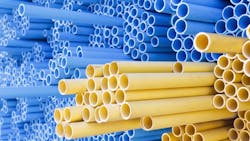Plumbing Study Shows Higher Flow Velocities and Right-Sizing Design Strategies Key to Building Water Quality
Key Highlights
- Higher flow velocities lead to better water quality by increasing residual disinfectants and reducing microbial activity and nitrification
- Smaller diameter pipes (3/8") benefit most from high flow rates, aiding in biofilm control and water clarity
- Regular flushing is essential to prevent stagnation, disinfectant loss, and microbial growth regardless of pipe material or size
PHILADELPHIA, PA — A new study from the Plastic Pipe and Fittings Association, conducted by researchers at Drexel University suggests higher flow velocities and smaller diameter plumbing results in better building water quality. The study is included in this month’s American Water Works Association’s journal, AWWA Water Science (Volume 7, Issue 4).
The Premise Plumbing Flow Rates, Linear Velocity, and Nitrification study, sponsored by the Plastic Pipe and Fittings Association, is a crucial first step toward the ultimate goal: obtaining clear, realistic and holistic scientific results to support the safe and appropriate right-sizing of North American water distribution systems and improving plumbing design in model plumbing codes.
Research Parameters
The Drexel research team investigated key proxies for water safety and biological activity in plumbing systems, including the impact of flow velocity on biofilm activity and the oxidation of ammonia, also known as nitrification, as well as the potential emission of pathogens from pipes. Tests were conducted on multiple materials. Pipes made of copper, PEX, and CPVC, were flushed five days a week or once a week and the discharged water analyzed.
Critically, researchers utilized a pre-existing, aged-in-place, single-pass plumbing system rig supplied with municipal chloramine-treated water. Prior studies have not typically examined the impact of velocity on biological water quality in real building systems, as they were often conducted in non-plumbing systems, with new pipes, or with synthetic recirculating water, and did not represent a real plumbing system.
Key Study Findings
Higher flow velocity generally leads to better water quality, with higher residual disinfectant levels, less degradation of ammonia, lower turbidity (cloudiness) levels, and lower adenosine triphosphate (ATP) levels, which indicates the presence and quantity of microorganisms. This suggests that higher flow rates can help scour the biofilm, potentially alter the morphology (the form, structure, and outward appearance) of the biofilm and reduce microbial activity and nitrification.
The most significant benefits for biofilm control are found in smaller diameter pipes (3/8") with high flow velocity.
Frequent flushing is crucial for maintaining water quality. Pipes flushed only once a week tended to reach a similar state of disinfectant loss and nitrification progression, regardless of pipe material, diameter, or velocity. This highlights the importance of regular water use or flushing to prevent water quality degradation due to stagnation.
Deciding on the ideal plumbing system design involves weighing multiple factors, including cost, durability, and water quality considerations.
-
Although copper pipes provided some level of microbial inhibition for ammonia, the report cautions that copper might selectively favor the growth of opportunistic pathogens such as Legionella.
-
In low-use conditions, cloudiness and opaqueness (known as turbidity) were substantially higher in copper pipes compared to PEX and CPVC.
Critical Factor
"The study clearly demonstrates that flow velocity in plumbing systems is a critical factor in maintaining water quality and provides significant evidence for pipe selection," said Mike Cudahy, Codes and Standards Specialist of The Plastic Pipe and Fittings Association. "We hope it will serve as an aspirational starting point for future scientific studies by other researchers to focus tests on realistic water sources and plumbing scenarios.”
Further work is needed to understand the generality of the results from this study, explore additional factors such as water temperature, and to develop evidence-based guidelines for building plumbing system design and operation.
Learn more by visiting the Pastic Pipe and Fittings Association website at https://www.ppfahome.org.
